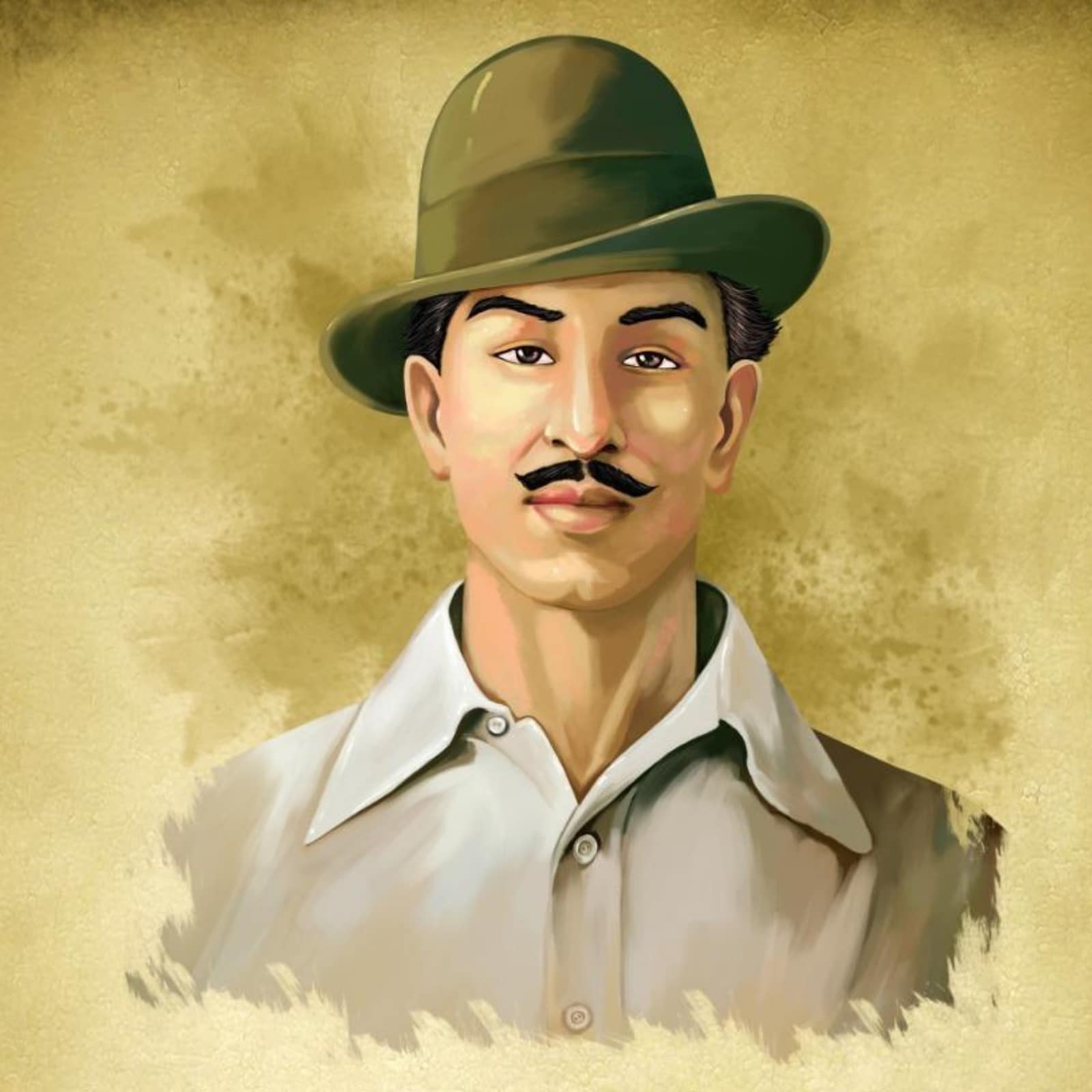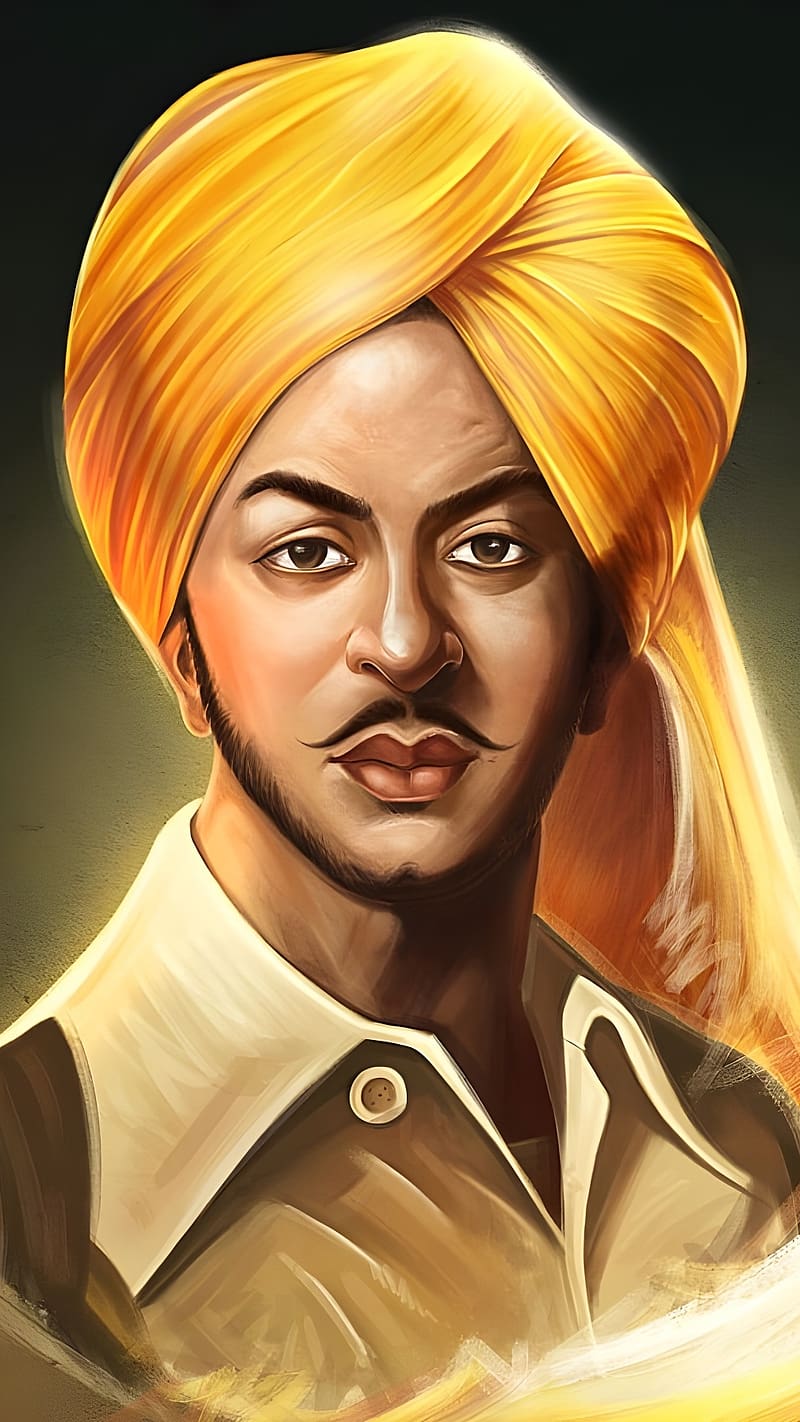“Bhagat Singh: A Visionary Revolutionary and Martyr for Independence”
Bhagat Singh, a legendary figure in the Indian freedom movement, is a symbol of unwavering bravery, persistence, and a relentless quest of justice. Born on September 28, 1907, in Banga, Punjab, Bhagat Singh rose to prominence during the tumultuous era of British colonial rule due to his inspiring leadership. His unflinching commitment to the cause of independence was proven by his early involvement in the non-cooperation movement and his later active participation in the revolutionary operations of the Hindustan Socialist Republican Association (HSRA).The event that made him famous was the Lahore Conspiracy Case, in which he and his allies attempted to exact revenge for the passing of Lala Lajpat Rai and entered the annals of martyrs with a peaceful protest. Bhagat Singh’s sharp mind and unwavering commitment to the cause made him stand out from his contemporaries. People around the nation and abroad were impacted by his courage in the face of adversity, especially during the hunger strike in jail. Generations after generation have been inspired by Bhagat Singh’s selfless sacrifice for an independent India that knows no bounds or dates. His legacy pays tribute to the unwavering courage of individuals who risked their lives to protect an idea so bold that it was willing to become a free and independent nation. Bhagat Singh will always be regarded as a visionary revolutionary and martyr who personified what it meant to give everything up for the welfare of society.
“Remembering the Icon: Celebrating Bhagat Singh’s Birth Anniversary and Legacy”
Today, we honor Bhagat Singh, the revolutionary leader, whose example has inspired countless numbers of people. This day marks Singh’s birth. Bhagat Singh, who was born on September 28, 1907, is regarded as a hero in Indian history for his valor, patriotism, and unwavering dedication to freedom.His passion for freedom propelled him to adopt revolutionary ideas in order to oppose the harsh British authority. We consider Bhagat Singh’s unwavering spirit, his sacrifices, and the unquenchable flame of nationalism he kindled on this momentous day. His scholarly works, such as the impactful article “Why I Am an Atheist” and his involvement in the Lahore Conspiracy Case, bear witness to his intellectual brilliance and commitment to the cause. The nation’s conscience was shaken by Bhagat Singh’s sacrifice on March 23, 1931, when, at the young age of 23, he accepted the gallows, which gave the independence movement more impetus. Let’s review the ideals that Bhagat Singh bravely gave his life in defense of as we commemorate the anniversary of his birth. His legacy instills in us a sense of obligation towards the land he wanted to free, while also encouraging us to respect justice, equality, and freedom. Bhagat Singh’s birth anniversary is not only a day of remembrance but also a call to action, imploring us to carry on his vision of a just and free India.
“Exploring the Connection: Unraveling Bhagat Singh Koshyari’s Legacy in Contemporary Context”
The Bhagat Singh In the history of Indian politics, Koshyari is a name that reverberates with significance. Examining the relationship to the legacy of Bhagat Singh Koshyari in the modern setting reveals a fabric woven with devotion, service, and support for democratic principles. As the governor of Maharashtra and an experienced politician, Koshyari leads by example with a background in public service. His travels demonstrate a thorough comprehension of India’s complex sociopolitical environment. Bhagat Singh Koshyari’s influence continues to influence the political narrative in the present, and his legacy is not limited to the annals of history. His leadership demonstrates a dedication to protecting democratic principles, promoting growth, and attending to the many demands of the folks. The leadership of Bhagat Singh Koshyari, who draws inspiration from the sacrifice and patriotism preached by the renowned freedom fighter Bhagat Singh, serves as a link between tradition and modernity in the current context. As we examine this relationship, it becomes clear that Bhagat Singh Koshyari’s legacy acts as a beacon of hope, encouraging people to make significant contributions to the advancement of the country and to uphold the values of service and dedication in the effort to create a more powerful, dynamic India.
“Icon in Frames: Capturing the Spirit and Legacy of Bhagat Singh in Images”

An icon whose spirit and legacy continue to resound via powerful photographs that capture his unshakable dedication to India’s independence, Bhagat Singh is forever remembered in the annals of history. These graphic stories capture certain events in time enabling us to see the fierce emotion that drove his revolutionary journey and the resolve written on his face. Every picture he took is proof of his bravery and demonstrates his deep dedication to a cause that went beyond his own safety. The pictures taken by Bhagat Singh are more than just souvenirs; they represent glimpses into a brave and selfless period in India’s freedom movement.
Bhagat Singh becomes more than just a revolutionary in these frames; he also becomes a figure of tenacity and an inspiration to future generations. These pictures portray a man who, in the face of injustice, stood tall and resolutely. His unwavering spirit, poised stance in the face of hardship, and intense gaze all contribute to this story. The well-known pictures of Bhagat Singh holding his His signature hat and combative attitude have become enduring visual symbols of his legacy.
By exploring these frameworks, we are able to establish a connection with a period of time when the fight for independence was a lived reality as well as a historical event. The timeless images of Bhagat Singh compel us to consider the costs incurred in order to have the freedom we do. They remind us of the unwavering spirit that has the power to reshape countries and spark transformation. With every picture taken, Bhagat Singh’s plea for justice is profoundly echoed, serving as a constant reminder to treasure and defend the hard-won freedom that he and many others envisioned for India.
“The Immortal Sacrifice: Reflecting on the Martyrdom and Legacy of Bhagat Singh’s Death”
The death of Bhagat Singh remains as an eternal sacrifice that reverberates across Indian history, signifying everlasting bravery and a steadfast dedication to the independence cause. At the young age of 23, this visionary revolutionary accepted martyrdom on March 23, 1931, leaving a lasting impression on the struggle against British colonial control. Together with his allies Rajguru and Sukhdev, Bhagat Singh deliberately risked the death penalty in order to achieve the greater goal of an independent and sovereign India.
Even though his passing was a great tragedy, it lit a spark that showed the way to independence. Bhagat Singh’s legacy lives on long after his death, embodying the spirit of selflessness and the never-ending search for justice. His bravery in facing his impending death served as a focal point for a people yearning for unity for liberty.
Thinking back on Bhagat Singh’s passing is an investigation of great sacrifice and a proof of the altruism that drove the independence movement. His legacy lives on in history books as well as in the collective recollections of a people who are motivated by his unwavering determination. Bhagat Singh’s sacrifice keeps fanning the torch of patriotism, reminding us that freedom is a right obtained by the courageous in making their own sacrifices. By remembering his sacrifice, we preserve Bhagat Singh’s unwavering spirit in the ongoing struggle for Indian sovereignty and pay tribute to the life he gave as well as the ideas he stood for.
summary
The legacy of Bhagat Singh endures and serves as a source of motivation for future generations. His unrelenting dedication to freedom, revolutionary spirit, and ultimate sacrifice made in the quest for independence serve as a tribute to the unstoppable force of courage and conviction. As we read about the numerous dimensions of his life, recall his birthdate, reflect on the significance of his passing, and study his famous photos, we are continually reminded of the immense impact one person can have on history.
The legacy of Bhagat Singh is a live narrative that transcends the pages of history and resonates throughout contemporary India. His values of justice, equality, and patriotism provide direction for those who are dedicated to improving the country. Whether by means of his revolutionary vision or the Bhagat Singh’s legacy lives on thanks to classic photos that capture his essence and inspire us to preserve the principles he advocated.
As we commemorate his birth, think back on his life, and remember his sacrifice, let’s hold the flame of freedom high and work to create a country that symbolizes the values that Bhagat Singh bravely sacrificed his life to defend. By accepting his legacy, we take on the role of stewards of the unwavering spirit that propels India’s continuous quest for sovereignty.
Q&As
- What role did Bhagat Singh fulfill in the fight for the freedom of India? He was who?
On September 28, 1907, the well-known revolutionary Bhagat Singh was born in Banga, Punjab. In India’s struggle for independence from British colonial authority, he was a key figure. His commitment to His participation in the non-cooperation campaign and revolutionary operations with the Hindustan Socialist Republican Association (HSRA) demonstrated the cause. Interestingly, he became a martyr in Indian history when he and his allies tried to exact revenge in the Lahore Conspiracy Case.
- What major contributions did Bhagat Singh make to the fight for independence?
Among Bhagat Singh’s most significant accomplishments are his involvement in the Lahore Conspiracy Case, his revolutionary actions with the HSRA, and his strong participation in the non-cooperation movement. His selflessness during the prison hunger strike demonstrated his everlasting dedication. He was a luminary because of his academic prowess and bravery in the face of difficulty. The spirit of sacrifice for an independent and sovereign India is embodied in his legacy.
- What does the day of Bhagat Singh’s birth represent, and how is he celebrated on this specific occasion?
People honor Bhagat Singh’s life, his sacrifices, and his unflinching dedication to independence on the anniversary of his birth. His birthday is September 28, 1907, and he was put to death on March 23, 1931. The day serves as a remembrance of the ideals that Bhagat Singh valiantly gave his life to defend as well as an appeal to preserve the ideas of justice, equality, and freedom.
- How important is Bhagat Singh Koshyari’s legacy to Indian politics today?
Maharashtra’s governor, seasoned politician Bhagat Singh Koshyari, is a significant player in Indian politics. His commitment to democratic ideals, public service, and addressing the many needs of the populace is demonstrated by his legacy. The leadership of Bhagat Singh Koshyari, who draws inspiration from the sacrifice and patriotism preached by the renowned independence fighter Bhagat Singh, acts as a link between tradition and modernity in the current setting.
- In what ways do pictures honor Bhagat Singh’s memory and spirit throughout the independence movement?
Photographs of Bhagat Singh are potent visual stories that illustrate his commitment to the liberation of India. His bravery, tenacity, and the intense enthusiasm that drove his revolutionary voyage are all captured in each picture. These pictures speak to a period of India’s independence movement and serve as a constant reminder of the price paid to achieve the freedom we take for granted today.

